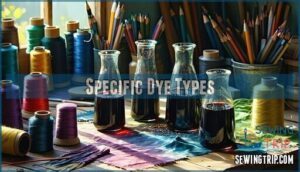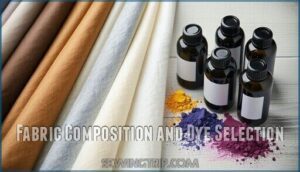This site is supported by our readers. We may earn a commission, at no cost to you, if you purchase through links.

Natural fibers like cotton, wool, and linen absorb black dye beautifully, while synthetic materials need special dyes designed for polyester or nylon.
The key is choosing the right dye for your fabric type. Start with clean, damp clothes for better color absorption.
Mix your dye according to package directions, add salt for cotton or vinegar for wool, then soak your garments in hot water.
The original color affects your results—white shirts turn jet black, while colored pieces create unique dark tones. Master these basics and you’ll discover professional-level dyeing secrets.
Table Of Contents
- Key Takeaways
- Choosing The Right Fabric Dye
- Dyeing Process
- Troubleshooting and Tips
- Instructions for Different Fabrics
- Enhancing Color and Neutralizing Undertones
- Tips for Specific Fabrics and Products
- Fabric Composition and Dye Selection
- Dyeing Techniques for Creative Projects
- Importance of Following Instructions
- Achieving Successful Results
- Frequently Asked Questions (FAQs)
- Conclusion
Key Takeaways
- You’ll need to match your dye type to your fabric – natural fibers like cotton work with fiber-reactive dyes, while synthetics require specialized formulas like Rit DyeMore.
- Your fabric’s original color affects the final result – white and light-colored clothes turn jet black, but darker fabrics won’t achieve true black without bleaching first.
- You can’t skip the prep work – pre-wash your garments, use hot water (140-180°F), add salt or vinegar as activators, and stir constantly to prevent uneven coloring.
- The key to lasting results is proper finishing – rinse with cold water until it runs clear, use a dye fixative to lock in color, and wash separately for the first few cycles.
Choosing The Right Fabric Dye
When you’re ready to transform your wardrobe, selecting the right black dye for clothes makes all the difference between success and disappointment.
Your fabric’s fiber type determines which dye chemistry will work best. Natural fibers like cotton and wool need different black clothing dye than synthetic materials like polyester or spandex.
The secret to perfect black? Match your dye chemistry to your fabric’s personality—cotton craves different treatment than polyester.
For cotton and linen, choose fiber-reactive dyes that create strong chemical bonds. Wool requires acid dyes mixed with vinegar.
Synthetic fabrics need specialized formulas like Rit DyeMore. Popular dye brands include Rit, Dylon, and Jacquard, each offering different color fastness levels. You can find options for purchasing black dye online.
Always check the package for safety precautions before starting. Some dyes require gloves and ventilation. The key is matching your fabric to the right dye chemistry. When you know how to dye clothes properly, you’ll achieve rich, lasting black results that won’t fade after washing.
Dyeing Process
Now that you’ve chosen your dye, it’s time to transform your fabric from its current color to rich, deep black.
The dyeing process involves six key steps that’ll guide you through preparation, mixing, soaking, and finishing to achieve professional-looking results at home.
Preparation and Equipment
Before you dye clothes black at home, proper workspace setup makes all the difference.
Start with fabric pre-washing using warm water to remove oils and sizing. Gather essential equipment: stainless steel pot, wooden stirring spoon, rubber gloves for dye safety, and tongs.
Check your water quality—hard water affects dye absorption. Exploring natural dyeing techniques can offer eco-friendly alternatives.
Equipment sourcing doesn’t require specialty stores; most items are kitchen basics, making it easy to get started with natural dyeing.
Mixing The Dye Solution
Perfect dye solutions start with proper mixing ratios and water temperature control.
A perfect dye solution is like a recipe—get the ratios right, and your fabric transforms beautifully.
Follow these essential steps for consistent results:
- Dissolve dye powder in hot water (140-180°F) before adding to your dye bath
- Add salt or soda ash as activators based on your fabric type
- Stir thoroughly to achieve uniform solution consistency without clumps
- Test dye concentration by checking color intensity before proceeding
Achieving the right shade involves understanding precise dye ratios.
Submerging and Stirring The Fabric
With your dye solution ready, carefully lower the damp fabric into the bath. Make certain of even submersion by gently pressing down with a long spoon to eliminate air bubbles.
Maintain stirring frequency every few minutes to prevent patchy results. Temperature consistency is key—keep the heat steady while you dye clothes black.
A dye mixing tool can make this process easier. Constant movement guarantees proper dye penetration throughout the fabric fibers, ensuring a successful dyeing process with even submersion.
Soaking and Rinsing
After stirring your fabric thoroughly, you’ll need to let it soak for proper dye fixation. The soaking duration depends on your desired darkness—typically 30 minutes minimum, but longer soaking creates richer blacks.
Keep stirring occasionally to prevent uneven coloring.
Once soaking’s complete, it’s time for fabric rinsing. Start with cool water to prevent dye bleeding, then gradually increase rinsing temperature. You’ll notice excess dye washing away—this is normal residue removal.
Continue rinsing until water clarity improves substantially, though it doesn’t need to run completely clear yet.
Here’s your rinsing checklist:
- Cool rinse first – prevents color bleeding and fabric washing disasters
- Gradual temperature increase – helps remove stubborn dye stains safely
- Multiple rinses – guarantees proper cleaning without damaging your newly dyed fabric
Fixative and Additional Rinsing
After your fabric has soaked up that rich black color, it’s time to lock it in place.
A dye fixative acts like a security guard for your newly dyed clothes, preventing that heartbreaking moment when your perfect black fades to gray after one wash.
You’ll find several fixative types at craft stores – commercial products work best, though white vinegar can pinch-hit for synthetic fabrics.
Spray or soak your fabric with the fixative, following package directions.
Then comes the marathon of rinsing.
Start with cold water – hot water opens fabric fibers and invites dye bleeding.
If you have hard water, consider water softeners to prevent mineral buildup that dulls color.
Multiple rinses are your friend here.
Keep rinsing until the water runs crystal clear.
This might take five or six rounds, but it’s worth every minute to dye fabric black successfully.
Washing and Drying
Once your fabric emerges from its dye bath transformation, proper washing and drying becomes your final hurdle to success.
You’ve invested time creating that perfect black shade, so don’t let poor garment care sabotage your efforts now.
Here’s your post-dyeing roadmap:
- Water Temperature: Use cold water for washing garments to prevent dye fading and color bleeding onto other items.
- Detergent Choice: Select color-safe detergent specifically designed for dark fabrics to maintain vibrancy.
- Shrinkage Control: Air-dry your newly dyed pieces instead of using high heat in the washing machine.
- Separate Loads: Wash dyed items alone for the first few cycles to avoid transferring color.
- Drying Methods: Choose gentle air-drying over machine drying to preserve your investment and prevent fabric damage.
Troubleshooting and Tips
Even experienced dyers encounter challenges like uneven color, fading, or fabric damage during the dyeing process.
You’ll learn practical solutions for common problems and discover techniques to achieve professional-quality results every time.
Adjusting Dye Strength and Time
Getting that perfect black isn’t always a one-shot deal.
Boost your dye concentration by using double the recommended amount—this cranks up color intensity substantially.
Extend immersion duration from 30 minutes to several hours for deeper saturation. Higher temperatures enhance dye absorption, while constant agitation prevents streaking.
Multiple dips build richer color than single attempts, and using these methods together can lead to a more perfect black.
Preventing Fading
Once you’ve mastered adjusting dye strength and timing, protecting your newly blackened fabric becomes your next priority.
Cold washing with gentle detergents preserves colorfastness and prevents premature fading. Use dye fixatives during the final rinse to lock in color vibrancy.
When you dye clothes black or dye fabric black, UV protection matters—dry indoors or in shade to avoid sun damage. Choose air-drying methods over high heat, which breaks down dye molecules.
These simple steps guarantee your dye faded clothes black project maintains its rich, deep appearance for years, ensuring a long-lasting and deep appearance.
Delicate Fabrics
Working with delicate fabrics when you dye clothes black requires a gentle touch and specialized approach.
These precious materials like silk, lace, velvet, and chiffon can transform beautifully, but they demand respect during the process.
Silk Dyeing needs cooler water temperatures to prevent protein fiber damage.
Lace Treatment requires hand-stirring instead of aggressive agitation.
Velvet Care means avoiding excessive heat that crushes the pile.
Chiffon Handling calls for shorter dye times since the thin fibers absorb color quickly.
Here’s your delicate fabric game plan:
- Test dye on hidden fabric scraps first
- Use acid dyes for silk and wool materials
- Keep water temperatures below 140°F for synthetics
- Handle Rayon Shrinkage by pre-shrinking before dyeing
Remember, patience pays off when dyeing natural fibers and synthetics—rushing leads to ruined favorites.
Multiple Dyeing Attempts
Sometimes your first attempt won’t deliver the deep black you’re after.
Don’t let uneven results discourage you – multiple dyeing sessions often solve color saturation issues.
When you dye clothes black at home, fiber damage becomes a concern with repeated treatments, so space attempts apart.
Watch for dye build-up on synthetic fabrics. If corrective measures are needed, try different techniques like stovetop methods when learning how to dye clothes effectively.
Specific Dye Types
Different black dye types deliver varying results depending on your fabric.
Fiber-reactive dyes work best for cotton and natural fibers, creating permanent chemical bonds. Acid dyes excel with wool and silk, requiring vinegar or citric acid activation.
Dispersion dyes target synthetic materials like polyester effectively. Rit Dye offers convenience for beginners, while professional dyes provide superior color depth and consistency.
Choose fiber-reactive dyes for cotton projects and acid dyes for protein fibers to achieve rich, lasting black coloration. Asian dyers often used iron mordants to create black dyes from local plant materials.
Avoiding Acrylic Paint and Sharpies
You might think acrylic paint or Sharpies offer a quick fix to dye clothes black, but they’ll leave you disappointed.
Here’s why these shortcuts backfire when you want to dye fabric black:
- Paint stiffens fabric into an uncomfortable, cardboard-like texture
- Sharpie ink issues cause colors to bleed and separate unpredictably
- Uneven Sharpie results create blotchy, inconsistent coverage
- Costly Sharpie dyeing requires dozens of markers for one garment
- Testing Sharpies first reveals how to dye clothes properly requires real fabric dye
Stick with black dye for clothes instead.
Instructions for Different Fabrics
You’ll need different approaches for different fabric types since cotton, wool, and synthetic materials each absorb dye in unique ways.
Each fabric requires specific dye types, temperatures, and timing to achieve that perfect black color you’re after.
Acrylic, Wool, and Cotton
Three distinct fabric fibers require different approaches when you want to dye clothes black.
Cotton offers excellent dye absorption, making it the easiest to transform with standard fabric dyes.
You’ll need higher temperatures and longer soaking times for deep, rich results.
Wool shrinkage risks demand gentle handling – use cooler water and acid-based dyes to prevent felting while achieving vibrant color.
Acrylic dyeing issues stem from synthetic composition, requiring specialized synthetic dyes and careful heat management.
Fiber blend challenges multiply when fabrics combine materials, as dye bath differences affect each component uniquely.
Always match your dye type to the primary fiber content for ideal results.
For ideal color, consider using a dye fixative product to ensure the best outcome with rich results and vibrant color.
Synthetic Fibers
Dyeing synthetics requires a different playbook than natural fabrics.
Polyester dyeing demands specialized disperse dyes and scorching temperatures around 200°F.
Acrylic challenges you with stubborn fibers that resist most dyes.
Spandex blends need gentle handling to avoid melting.
Nylon options work better with acid dyes at high heat.
Synthetic blends complicate the process since each fiber type responds differently.
You’ll need patience and the right synthetic-specific products to dye fabric black successfully on these modern materials.
Gather Supplies and Pre-wash Fabric
Getting your fabric preparation right sets you up for dyeing success. Start by gathering your supplies: black fabric dye, salt or vinegar, rubber gloves, stainless steel pot, wooden spoon, and thermometer.
Next, conduct a shrinkage test by washing a small fabric sample first. Prewash your garments in warm water using regular detergent – skip fabric softeners as they block dye absorption.
Choose cold water temperature for delicate items. Your drying method doesn’t matter much at this stage, but make certain the fabric’s completely clean before moving forward, ensuring complete cleanliness.
Heat and Dye Activation
Once your dye solution is ready, controlling temperature becomes vital for successful results.
The stovetop method offers precise heat control when you dye clothes black. Here’s your temperature roadmap:
- Heat water to 140°F for synthetic fabrics
- Reach 180°F for natural fibers like cotton
- Maintain consistent heat throughout dyeing time
- Add dye activator at ideal temperature
- Monitor fixation temperature with a thermometer
Heat sources affect dye solubility differently. Fiber swelling occurs at higher temperatures, allowing deeper penetration. Your dyeing temperature directly impacts color intensity and permanence.
Dye Absorption and Waiting Period
Once your fabric hits the dye bath, patience becomes your secret weapon.
Soaking duration depends on fabric type and desired color depth – lightweight cotton absorbs faster than heavy denim.
Temperature impact affects dye concentration penetration, so maintain consistent heat.
Stir occasionally to prevent uneven spots, but don’t overdo it.
Fabric weight influences dyeing time, with thicker materials needing longer exposure.
Watch for fabric reactivity changes as the dyeing process unfolds, ensuring ideal dye absorption throughout.
Rinsing and Washing
Start your initial rinse with lukewarm water, gently squeezing excess dye from the fabric.
Gradually switch to cold water until it runs completely clear—this prevents color bleeding later.
Choose a gentle detergent for your first washing machine cycle, using cold water temperature.
Air-dry your newly dyed clothes to avoid heat damage.
Clean your washing machine afterward to prevent future staining issues.
Enhancing Color and Neutralizing Undertones
You’ll need to adjust your dye mixture and timing to achieve the deep, rich black you’re after, especially if your fabric has stubborn color undertones that keep showing through.
Adding salt or vinegar to your dye bath, doubling your soaking time, and using a dye fixative can help neutralize those pesky hints of brown, gray, or faded color that prevent true black results.
Adjusting Dye Quantity
Perfect black starts with the right dye ratio for your fabric weight.
Double the standard dye quantity when targeting true black – this boosts color intensity and saturation levels substantially.
Heavier fabrics need stronger dye concentration to penetrate fibers completely. You’ll dye fabric black more effectively by calculating one packet per pound of dry fabric, then doubling it.
Light cotton requires less dye strength than thick denim. When you dye clothes black, remember that dye quantity directly controls your final color intensity and darkness, achieving a true black.
Salt/Vinegar for Color Enhancement
Beyond increasing dye quantity, you’ll want to harness salt and vinegar’s power to dye clothes black more effectively.
Salt benefits natural fibers by improving dye penetration and colorfastness impact. Add one cup of salt to your dye bath when working with cotton or linen.
Vinegar benefits synthetic materials through its acidic effects, creating deeper saturation. Mix half a cup of white vinegar into your solution for polyester blends.
Proper application timing means adding these enhancers before fabric enters the dye clothes at home process.
Double Dyeing Time
When you’re aiming for enhanced absorption and color saturation, doubling your standard dyeing time transforms good results into great ones.
Instead of the typical 30-minute soak, let your fabric luxuriate for a full hour in the dye bath.
This extended immersion allows the best black dye to penetrate deeper, maximizing darkness and preventing fading when you dye clothes at home.
Using a Dye Fixative
The right dye fixative transforms your black dye project from good to spectacular, locking in that deep, rich color you’re after.
Think of it as insurance for your newly dyed clothes—it prevents fading and guarantees colorfastness through countless washes.
Here’s how to master fixative application:
- Match fixative types to your dye—salt-based for fiber-reactive, acid for protein fibers
- Apply immediately after final rinse while fabric’s still damp
- Soak thoroughly for 20 minutes, ensuring complete saturation
- Test environmental impact with eco-friendly commercial or DIY fixatives
- Rinse completely until water runs clear before final wash
Adjusting Dye Mixtures for Undertones
Correcting unwanted color casts requires strategic dye mixture adjustments that’ll transform your fabric into the perfect black shade.
When you’re dyeing clothes black, understanding undertones makes all the difference between muddy results and rich, professional-looking fabric.
For neutralizing redness in your black dye, add a tiny amount of green dye to counteract warm tones.
Combating green undertones works best with red additions.
Blue subtleties can be balanced using orange or yellow correction techniques, while yellow correction requires purple or blue additions to achieve cool black results.
Gray balancing happens when you’ve added too much corrective color—simply increase your black dye concentration.
These black dye tips help you dye clothes blacker by understanding color wheel principles.
Start with small amounts when adjusting mixtures.
A warm black contains subtle red or brown undertones, while cool black leans toward blue or purple.
Test your mixture on fabric scraps first to avoid disappointing results.
Experimenting With Dye Additives
Dye additive experimentation reveals your fabric’s hidden potential, transforming ordinary black into extraordinary depth.
These simple additions can revolutionize your dyeing results and help you dye clothes blacker than ever before.
- Salt benefits – Enhances color absorption and prevents streaking during the dyeing process
- Vinegar effects – Acts as a natural dye activator for protein fibers like wool and silk
- Soda ash – Creates alkaline conditions that boost fiber-reactive dye performance substantially
- Dye boosters – Commercial products that intensify color saturation and improve wash-fastness
- Fixative types – Post-dye treatments that lock in color and prevent future fading
These black dye tips transform amateur attempts into professional-quality results.
Tips for Specific Fabrics and Products
Different fabrics need specific approaches to achieve that perfect black color you’re after.
Heavy materials like denim and thick coats require extra dye, longer soaking times, and sometimes multiple treatments to penetrate their dense fibers completely, which can be a complete process.
Denim and Coats
Heavy fabrics like denim and coats present unique challenges when dyeing fabric black. The thick weave and dense construction can limit dye penetration, making it harder to achieve uniform color distribution.
Here’s how to tackle these wardrobe staples:
- Denim Weight Considerations: Heavier denim requires longer soaking time and higher dye concentrations. Expect 12-ounce denim to need double the standard dye amount compared to lightweight cotton.
- Coat Linings Management: Remove detachable linings before dyeing, or accept that they’ll likely dye differently than the outer fabric. Synthetic linings won’t absorb dye like natural fibers.
- Distressed Denim Preparation: Clean all dirt from worn areas first. Frayed edges and holes can create uneven dye absorption, giving you natural color variation.
- Black Coats Success Tips: Use the stovetop method for better heat control. Stir constantly to prevent streaking, and consider multiple dye baths for deeper color saturation.
When you dye clothes darker, patience becomes your best friend with these hefty fabrics. For sewing denim, consider using stronger, sharp needles to prevent breakage.
Product Recommendations
Heavy-duty projects call for reliable products that won’t let you down. The Best Black Dyes start with Rit All-Purpose Liquid Dye, which handles cotton, silk, and wool beautifully.
For synthetics, you’ll need Synthetic Fabric Dyes like Rit DyeMore. Natural Fiber Dyes work perfectly with Dharma Trading’s Procion MX series.
| Dye Type | Best For |
|---|---|
| Rit All-Purpose | Cotton, wool, silk |
| Rit DyeMore | Polyester, acrylic |
| Procion MX | Natural fibers |
| Dylon Multi-Purpose | Blended fabrics |
| Jacquard Acid Dyes | Wool, nylon |
Always pair your chosen black fabric dye with Dye Fixatives and Color Safe Detergents for lasting results.
Fabric Composition and Dye Selection
Understanding your fabric’s makeup is like having a roadmap to dyeing success. Fiber types determine everything about your black dyeing journey.
Natural fibers like cotton, wool, and silk welcome most dyes with open arms, while synthetic fibers play harder to get. Dye compatibility isn’t guesswork.
Cotton and linen love fiber-reactive dyes, which create lasting bonds with the fabric. Wool and silk prefer acid dyes that work in slightly acidic conditions.
Polyester and other synthetic fibers need disperse dyes specifically designed for their stubborn nature. Fabric weight affects how dye penetrates your material.
Lightweight fabrics absorb color faster than heavy ones. Fabric content labels tell you everything – look for percentages of natural versus synthetic materials.
For summer projects, remember that lightweight fabrics offer graceful flow. Black undertones can surprise you.
Some dyes lean purple, others go navy. Professional dye brands like Procion and Jacquard offer more predictable results than drugstore options.
Check fabric dyeing forums for real user experiences with specific dye selection combinations before committing to your project.
Dyeing Techniques for Creative Projects
You can transform your plain black fabric into stunning artistic pieces using specialized dyeing techniques that create unique patterns and effects.
These methods, including ombre gradients, dip-dye fading, shibori folding patterns, and tie-dye designs, let you customize your clothing with professional-looking results at home.
Ombre
Creating ombre effects transforms ordinary garments into stunning gradient masterpieces. Choose your fabric choice carefully—cotton and natural fibers accept dye more evenly than synthetics.
Start with gradient techniques by mixing varying dye concentrations, from light to dark. Color blending requires patience as you gradually dip sections at different depths.
For bleach ombre, reverse the process by lightening darker fabrics first. These dyeing techniques let you dye clothes successfully with professional-looking results. Follow proper dye clothes instructions, and you’ll master this rewarding technique that gives you complete creative control.
Dip-dye
Beyond creating smooth ombre shifts, you can master dipdye techniques to dye clothes successfully with striking visual impact.
This method involves repeatedly dunking sections of your fabric into black fabric dye at different depths and durations. Start with clean, damp fabric—Fabric Weight affects how quickly dye penetrates, so lighter materials work faster.
Create Layered Dips by submerging the bottom third for five minutes, then two-thirds for three minutes, leaving the top untreated.
Dye Migration naturally occurs as pigments spread upward, softening harsh lines.
Experiment with Color Combinations by adding gray or navy sections before your final black layer. Control Gradient Intensity by adjusting soaking times and dye concentration when dyeing fabric black.
Shibori
Shibori techniques transform ordinary fabric into stunning artworks through strategic fabric manipulation and resist methods.
This ancient Japanese art uses precise folding, binding, and clamping before applying black dye.
Unlike simple tiedye, shibori creates sophisticated geometric patterns through controlled compression.
Try the basic kanoko method: pinch small sections, bind tightly with string, then submerge in your dyeing solution.
The bound areas resist the dye, creating striking white circles against deep black backgrounds, resulting in professional-looking results through the use of resist methods.
Tie-dye
Moving from structured folding methods, tie-dye opens up a world of creative possibilities for your black fabric dyeing project. This vibrant technique transforms ordinary garments into eye-catching masterpieces through strategic band placement and thoughtful dye application.
Your fabric choice substantially impacts the final result. Cotton and natural fibers absorb dye most effectively, while synthetic materials require specialized dye techniques. Start with clean, damp fabric for ideal color penetration.
Here are four essential tie-dye approaches for black fabric dyeing:
- Spiral patterns – Twist fabric from center outward, securing with rubber bands for classic swirls
- Bullseye designs – Pinch fabric at center point, wrap bands at intervals for concentric circles
- Stripe effects – Fold fabric accordion-style, bind tightly for bold linear patterns
- Crumple method – Scrunch fabric randomly, band loosely for organic textures
Experiment with different color combinations and pattern techniques. Remember, tiedye patterns work beautifully even when creating solid black results, adding subtle texture variations that catch light differently.
Importance of Following Instructions
You’ll get professional-looking results when you follow each step precisely, from measuring dye amounts to maintaining proper water temperature.
Skipping instructions often leads to uneven color, fading, or fabric damage that can’t be fixed later.
Fabric Composition
Understanding your fabric’s makeup determines whether you’ll achieve that perfect black or end up with disappointing results.
Natural fabrics like cotton and wool soak up fabric dye beautifully, while synthetic fabrics need specialized black dye formulations to penetrate their fibers properly.
Fiber types affect how color bonds with your garment.
Cotton’s open weave structure welcomes dye molecules, but polyester’s tight synthetic construction resists standard dyes.
Fabric blends create unpredictable outcomes since each fiber reacts differently.
Material weight influences dye penetration too – lightweight fabrics absorb faster than heavy denim.
Don’t ignore shrinkage potential when heating your dye bath.
Wool can felt, silk may pucker, and cotton often shrinks.
Check your garment’s label before starting.
Mixed fabric types require compromise – you might get uneven coloring where natural and synthetic fibers meet.
| Cotton | Silk | Wool | Linen | Polyester | Nylon | Rayon | Acrylic | Spandex | Denim | Blends |
|---|---|---|---|---|---|---|---|---|---|---|
| Perfect absorption | Delicate beauty | Shrinks easily | Crisp results | Needs special dye | Color-hungry | Acts natural | Dye-resistant | Stretches fate | Thick challenge | Unpredictable mix |
Dye Selection
After understanding your fabric composition, you’ll need the right black fabric dye to match your fiber types.
Natural fabrics like cotton work best with fiber-reactive dyes, while synthetics need specialized formulas like Rit DyeMore.
Popular dye brands offer both liquid and powder dye forms – liquids distribute more evenly.
Budget options include basic Rit dyes, though professional-grade products provide better colorfastness agents.
What dye to use depends on your fabric’s makeup, so check labels before dyeing fabric black.
Remember that original fabric color can substantially impact the final result.
Dyeing Techniques
Your dyeing technique selection determines whether you’ll achieve rich, even black or end up with patchy disappointment.
Master these core approaches:
- Stovetop Dyeing – Heat accelerates dye absorption for darker, more permanent results
- Cold Water methods – Gentler on delicate fabrics but requires longer processing times
- Specialized techniques – Dip Dyeing creates gradients while Tie-Dye offers creative patterns
Each technique demands specific Fiber Manipulation skills and timing considerations for ideal black fabric dye results.
Achieving Successful Results
Following proper dyeing instructions sets you up for success, but achieving professional-looking results requires attention to key factors.
Your fabric’s reaction to black fabric dye depends on several elements working together.
Dye consistency starts with thorough mixing and constant stirring during the process.
You’ll avoid streaks by keeping fabric moving and ensuring even coverage throughout the dye bath.
Color fastness improves when you maintain proper water temperature and allow adequate soaking time.
| Success Factor | What It Means |
|---|---|
| Proper Preparation | Clean fabric absorbs dye evenly |
| Temperature Control | Hot water opens fibers for better penetration |
| Adequate Time | Longer soaking creates deeper black |
| Thorough Rinsing | Removes excess dye preventing bleeding |
Shade matching your expectations means understanding that wet fabric appears darker than the final result.
These dyeing tips and tricks combined with patience create stunning results when dyeing fabric black successfully.
Frequently Asked Questions (FAQs)
Can I dye colored clothes black?
Like medieval alchemists transforming base metals, you can dye colored clothes black, but darker fabrics won’t achieve true black.
Light-colored garments work best, and it is essential to use fabric-specific dyes.
Expect mixed results on vibrant colors.
What dye makes clothes black again?
Black fabric dye specifically designed for your fabric type will restore that deep color. Rit Back to Black works great for natural fibers, while Rit DyeMore handles synthetics perfectly.
Which clothes cannot be dyed?
You can’t dye waterproof fabrics, heavily treated synthetic blends over 65% polyester, leather, faux leather, or items with permanent finishes. Pre-existing dark colors won’t take black dye effectively either.
Can I dye clothes with existing colors?
Colorful clothes can catch dye, but darker shades won’t show much change. You’ll need bleach first to strip existing colors, then dye black. Light-colored fabrics work best for dramatic transformations.
How long does black dye last on fabric?
Properly dyed black fabric typically lasts several years with good care.
You’ll see gradual fading after 20-30 washes, especially with hot water and harsh detergents.
Cold water washing extends longevity substantially.
Is it safe to dye clothes at home?
Steam rises from your kitchen pot as you transform faded garments into fresh wardrobe staples.
Yes, it’s completely safe when you follow basic precautions: use gloves, make certain good ventilation, and keep dye away from food prep areas.
Can I dye clothes in a washing machine?
Yes, you can dye clothes in your washing machine.
Use the hottest water setting and add salt or vinegar to help the dye set.
Run an empty cycle afterward to clean out any remaining dye residue.
What happens if I overdye my garment?
Too much of a good thing can backfire.
Overdyeing darkens your garment beyond repair, creating muddy colors or uneven patches.
You’ll lose the original fabric texture, and colors won’t wash out easily afterward.
Conclusion
Mastering the art of fabric dyeing is like discovering a treasure chest of wardrobe possibilities.
Now you know exactly how to answer "can I dye my clothes black" with confidence. You’ve learned fabric selection, proper preparation techniques, and troubleshooting methods that guarantee professional results.
Remember to match your dye type to your fabric composition, follow manufacturer instructions precisely, and don’t rush the process.
With these skills, you’ll transform faded garments into striking black pieces that look professionally done.
- https://www.dharmatrading.com/cgi-bin/procion_yields.cgi?colornumber_inp=1&colornumber=6A&weightozs=7.05&weightlbs=0.44&weightgrams=200&action=Get+Estimate
- https://www.reddit.com/r/sewing/comments/nbj4u1/can_you_dye_fabric_with_just_acrylic_paint_and/
- https://www.thecreativefolk.com/dye-clothes-with-acrylic-paint/
- https://www.cotton.org/pubs/cottoncounts/fieldtofabric/dyeing.cfm
- https://sewport.com/fabrics-directory/nylon-fabric

























